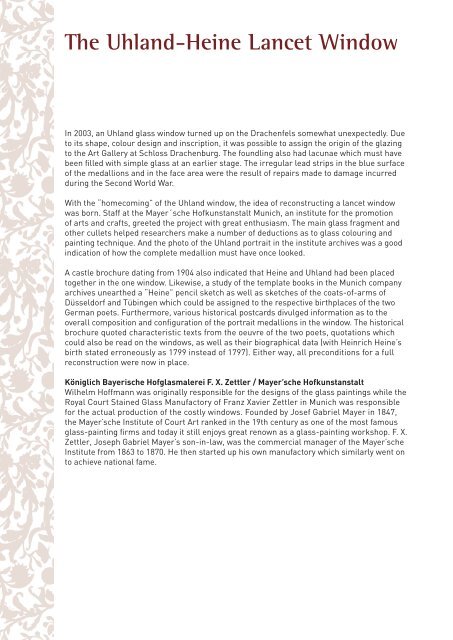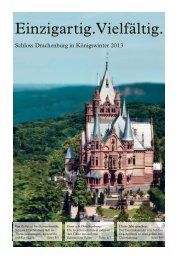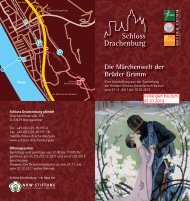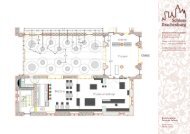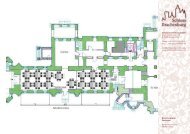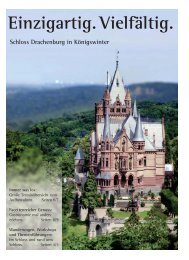North Tower - Schloss Drachenburg
North Tower - Schloss Drachenburg
North Tower - Schloss Drachenburg
You also want an ePaper? Increase the reach of your titles
YUMPU automatically turns print PDFs into web optimized ePapers that Google loves.
The Uhland-Heine Lancet Window<br />
In 2003, an Uhland glass window turned up on the Drachenfels somewhat unexpectedly. Due<br />
to its shape, colour design and inscription, it was possible to assign the origin of the glazing<br />
to the Art Gallery at <strong>Schloss</strong> <strong>Drachenburg</strong>. The foundling also had lacunae which must have<br />
been fi lled with simple glass at an earlier stage. The irregular lead strips in the blue surface<br />
of the medallions and in the face area were the result of repairs made to damage incurred<br />
during the Second World War.<br />
With the “homecoming” of the Uhland window, the idea of reconstructing a lancet window<br />
was born. Staff at the Mayer´sche Hofkunstanstalt Munich, an institute for the promotion<br />
of arts and crafts, greeted the project with great enthusiasm. The main glass fragment and<br />
other cullets helped researchers make a number of deductions as to glass colouring and<br />
painting technique. And the photo of the Uhland portrait in the institute archives was a good<br />
indication of how the complete medallion must have once looked.<br />
A castle brochure dating from 1904 also indicated that Heine and Uhland had been placed<br />
together in the one window. Likewise, a study of the template books in the Munich company<br />
archives unearthed a “Heine” pencil sketch as well as sketches of the coats-of-arms of<br />
Düsseldorf and Tübingen which could be assigned to the respective birthplaces of the two<br />
German poets. Furthermore, various historical postcards divulged information as to the<br />
overall composition and confi guration of the portrait medallions in the window. The historical<br />
brochure quoted characteristic texts from the oeuvre of the two poets, quotations which<br />
could also be read on the windows, as well as their biographical data (with Heinrich Heine’s<br />
birth stated erroneously as 1799 instead of 1797). Either way, all preconditions for a full<br />
reconstruction were now in place.<br />
Königlich Bayerische Hofglasmalerei F. X. Zettler / Mayer’sche Hofkunstanstalt<br />
Wilhelm Hoffmann was originally responsible for the designs of the glass paintings while the<br />
Royal Court Stained Glass Manufactory of Franz Xavier Zettler in Munich was responsible<br />
for the actual production of the costly windows. Founded by Josef Gabriel Mayer in 1847,<br />
the Mayer’sche Institute of Court Art ranked in the 19th century as one of the most famous<br />
glass-painting fi rms and today it still enjoys great renown as a glass-painting workshop. F. X.<br />
Zettler, Joseph Gabriel Mayer’s son-in-law, was the commercial manager of the Mayer’sche<br />
Institute from 1863 to 1870. He then started up his own manufactory which similarly went on<br />
to achieve national fame.


